
by Callan Bentley Thursday, January 5, 2012
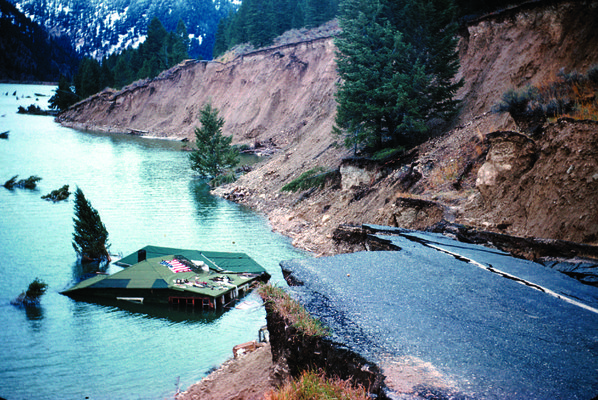
Disrupted ground and trees of a landslide caused by the Hebgen Lake earthquake. U.S. Geological Survey Photographic Library
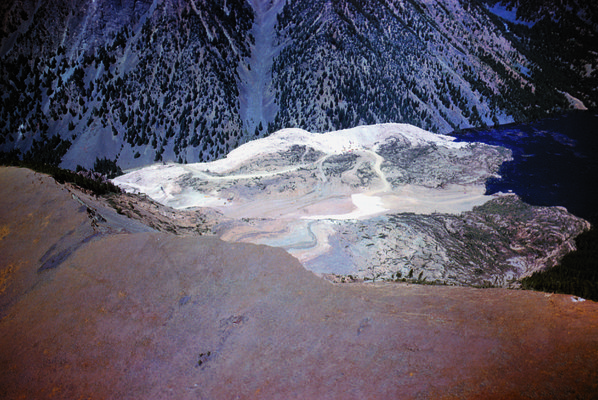
The Madison River landslide rode across the valley at speeds of up to 160 kilometers per hour and up the opposite valley wall. The leading edge, shown here, is the white ridge of dolomite boulders. U.S. Geological Survey Photographic Library
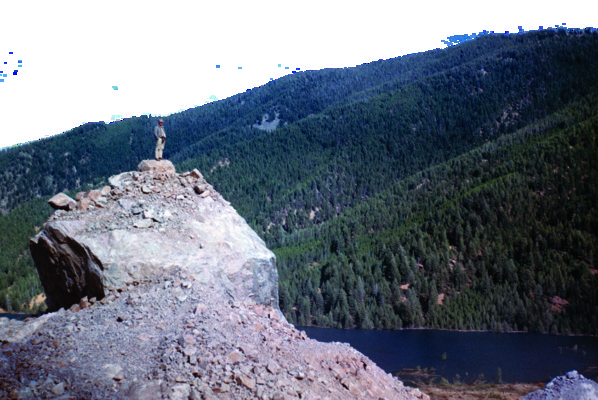
A large dolomite boulder on the east side of the Madison River landslide, with Earthquake Lake in the background. U.S. Geological Survey Photographic Library
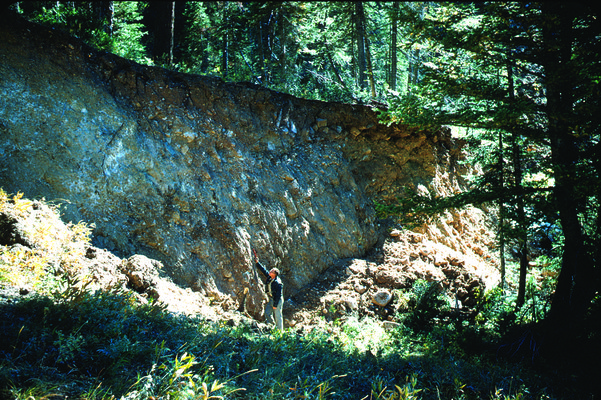
A fault scarp near Red Canyon Creek in Montana shows a 5.7-meter displacement from the earthquake. U.S. Geological Survey Photographic Library
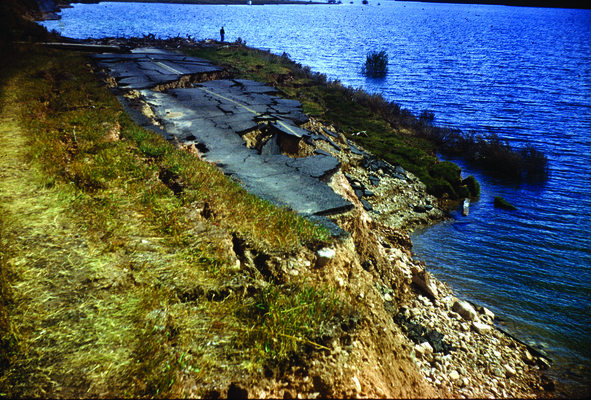
Highway 287, near Hebgen Lake, was fractured in the earthquake. U.S. Geological Survey Photographic Library
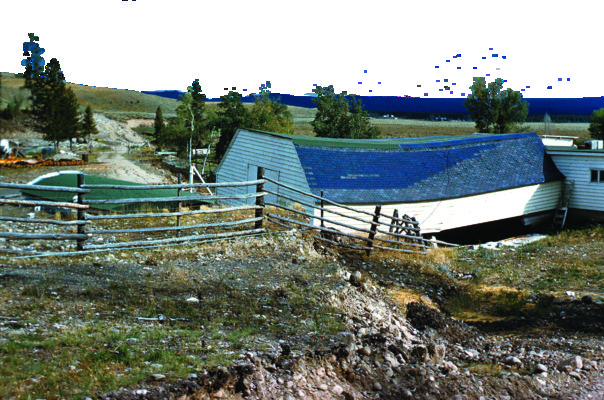
A barn collapsed by the fault scarp extending from the foreground through the barn and across the stream. U.S. Geological Survey Photographic Library
You’re camping in Montana, doing some fly fishing on the Madison River. You’ve had a full day of beautiful Big Sky country weather, and had fresh trout for dinner. In your campsite at the Rock Creek Campground, you go to bed satisfied and happy. It’s a nice enough evening that you sleep out in the open, to better appreciate the stars. The waters of the Madison gurgle by, gently lulling you to sleep while Orion shines above.
Suddenly, you awake in the middle of the night to the ground under your sleeping bag shaking, a thundering roar filling your ears. Above you, the side of the dark mountain detaches, and near its crest, you see a bright strip of rock opening up in the moonlight. Below it, the mountain’s solid form becomes dynamic, jumbled. Time slows down. Then in just two seconds, it is there, before you, snapping trees, a big seething mass of rock and dirt. It is upon you. Now there is nothing but darkness.
On the night of Aug. 17, 1959, at 11:37 p.m. local time, a magnitude-7.5 earthquake struck just northwest of Yellowstone National Park, near Hebgen Lake in southwestern Montana. Almost instantly, the shaking triggered a massive landslide that buried 19 people beneath 73 million metric tons of debris, and fatally wounded nine others. Fifty years later, the scars remain.
The orientation of the grains of the local rock, a schist, dip into the canyon carved by the Madison River. Because this foliation was shallowly dipping, it intersected the steep wall of the valley, creating a plane of weakness. When the mighty force of the earthquake shook this weak juncture, the mountain broke and crumbled, and there was nowhere for the loose rock to go but down. Overlying sedimentary rocks were carried along too, down into the valley and almost half a kilometer up the other side of the canyon. Within an instant, the mountain filled the valley, damming the Madison River. Behind the natural dam, Earthquake Lake was created, complete with forests of drowned trees.
Martin Stryker of Berkeley, Calif., was 15 years old when the quake struck. He was camping with his father, stepmother and two brothers at the Cliff Lake Campground. Stryker remembers waking with the motion. “At first, I thought it was a thunderstorm,” he recalls. That perspective changed when he got out of his tent. A tree collapsed on their car, and their dog ran away. As he woke up, Stryker realized that the ground was shaking. “When you’re in something of that magnitude, you can almost hear the plates grinding together,” he says.
Turning toward the tent where his father and stepmother were sleeping, Stryker saw something that made his blood run cold. A boulder almost two meters high was sitting on top of his parents’ tent. “I didn’t immediately alert my brothers. I went to see if there was anything I could do, and there wasn’t.” He dressed himself and took charge of his siblings. “I told them that Dad and Ethyl have been killed. There’s a major earthquake going on, and we need to get out of here.”
Stryker got his brothers to cabins at an adjoining lake. There, he found some drunken but shocked revelers. Convincing them not to drive out on the damaged roads, the teenager took charge. “I told them to wait until the sun comes up.” When dawn came, their small group evacuated the area. The larger scene was more chaotic. He and his brothers ended up in Virginia City, Mont., about an hour away, where they stayed with a local rock shop owner, Clint Evans, and his family for several days until airline officials arranged for the boys to fly back to California.
Mildred “Tootie” Green also remembers the event. She and her family were among the families camped closest to the landslide. When the Madison River was displaced by the landslide, a huge wall of muddy water and debris swept over their campsite. Their tent was half-buried, but her husband Ray managed to grab the hand of their son Steve and rescue him just in time. A registered nurse, Green immediately went to work helping those who were still alive. “I was the luckiest person there,” she says. “I was busy. I didn’t have to worry about what had happened or what was going to happen.” By 9 a.m. the next morning, a doctor had arrived and smokejumpers started parachuting into the affected area as part of the rescue and recovery efforts. Meanwhile, Green kept busy administering first aid to the large number of injured people. By 11 a.m., helicopters were arriving to ferry out the survivors.
The Hebgen Lake earthquake, as it came to be known, was a magnitude-7.5 event. It was preceded by a magnitude-6.3 foreshock, and followed by more than 350 aftershocks over the next four days. The earthquake was caused by the extensional tectonics — stretching of the crust from east to west — that characterize the American West and are best expressed in the Basin and Range province. The stresses associated with this stretching had been building up for many years, until they finally exceeded the frictional strength of the Hebgen Lake Fault. When the fault moved, the valley dropped precipitously, relative to the mountains just north of it. This motion triggered the landslide and numerous rockfalls like the one that killed Martin Stryker’s father and stepmother.
Jack Epstein, a geologist emeritus with the U.S. Geological Survey in Reston, Va., was working as a field assistant in Montana when the earthquake hit. As fate would have it, his team’s campsite was essentially at the epicenter, on a hill overlooking Hebgen Lake. His mapping project was temporarily put on hold, and Epstein spent the next several weeks escorting various teams of geologists around the area. In spite of the human toll, Earth processes were on display in an unprecedented way, he says. “It was a marvelous opportunity for a beginning geologist.”
This month, on the occasion of the 50th anniversary of the quake, Stryker plans to return with one of his brothers to the Madison River Valley, where he will participate in a commemoration organized by Joanne Girvin of the U.S. Forest Service. “We want folks to remember that earthquakes do happen in this area,” Girvin says. “We want to learn from those people who survived this earthquake.”
This month’s four-day commemoration includes events hosted by Epstein and Stryker and others. Epstein will even reprise his half-century-ago role as a field trip leader for those with an interest in the geology of the quake. In addition, modern smokejumpers will demonstrate a proficiency jump at Refuge Point, while the smokejumpers from 1959 will be on hand to answer questions about their role in the rescue operations. The commemoration will conclude with a service at the Memorial Boulder, a two-story-tall boulder of dolostone estimated to weigh 2,700 metric tons that commemorates those who lost their lives in the quake, 28 in all.
Tootie Green hopes to join in the commemoration this summer, but at 80 years old, she knows the trip is not as easy as it used to be. Even if she can’t make it, Green notes that the experience left her “more appreciative of being alive.”
© 2008-2021. All rights reserved. Any copying, redistribution or retransmission of any of the contents of this service without the expressed written permission of the American Geosciences Institute is expressly prohibited. Click here for all copyright requests.